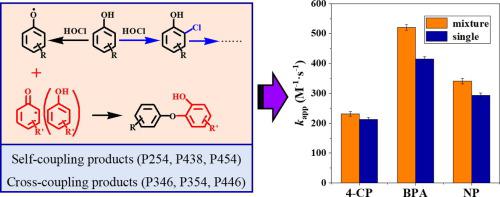Chemical Engineering Journal ( IF 13.3 ) Pub Date : 2020-07-07 , DOI: 10.1016/j.cej.2020.126140 Wenrui Xiang , Ruijuan Qu , Xinghao Wang , Zunyao Wang , May Bin-Jumah , Ahmed A. Allam , Feng Zhu , Zongli Huo

|
Phenolic endocrine disrupting chemicals (EDCs) such as bisphenol A (BPA), 4-chlorophenol (4-CP) and nonylphenol (NP) are the most commonly detected pollutants in natural environments. The transformation of mixtures of the three phenolic pollutants during chlorination process was studied for the first time in this work. Single phenol can be effectively removed by free chlorine via electrophilic substitution and electron transfer reactions, with the generation of chlorinated phenols and self-coupling products. In mixture solution, the apparent second-order rate constants (kapp) of 4-CP, BPA and NP at pH 8.0 was increased by 8.6%, 25% and 16%, respectively, as compared to the degradation of single-compound. According to the products identification and density functional theory calculations, the cross-coupling process can occur more easily than the self-coupling reaction, which might accelerate the removal of phenolic mixtures. In addition, humic acid (HA) exerts some inhibitory effect on the degradation of phenolic compounds, due to the competition for chlorine consumption and the reduction of phenoxy radicals to parent phenols. These findings shed light on the environmental fate of phenolic mixtures during aqueous chlorination process, which provide new information for the application of chlorination in water and wastewater treatment.
中文翻译:

通过水氯化法除去4-氯酚,双酚A和壬基酚混合物并形成偶联产物
酚类内分泌干扰化学物质(EDC),例如双酚A(BPA),4-氯苯酚(4-CP)和壬基苯酚(NP)是自然环境中最常见的污染物。这项工作是第一次研究在氯化过程中三种酚类污染物的混合物的转化。游离酚可通过亲电取代和电子转移反应被游离氯有效去除,并生成氯化酚和自偶联产物。在混合溶液中,表观二阶速率常数(k app与单一化合物的降解相比,4-CP,BPA和NP在pH 8.0时的pH值分别提高了8.6%,25%和16%。根据产物鉴定和密度泛函理论计算,交叉偶联过程比自偶联反应更容易发生,这可能会加速酚类混合物的去除。此外,由于竞争消耗氯气和将苯氧基自由基还原为母体酚,腐殖酸(HA)对酚类化合物的降解具有一定的抑制作用。这些发现揭示了水性氯化过程中酚类混合物的环境命运,这为氯化在水和废水处理中的应用提供了新的信息。











































 京公网安备 11010802027423号
京公网安备 11010802027423号